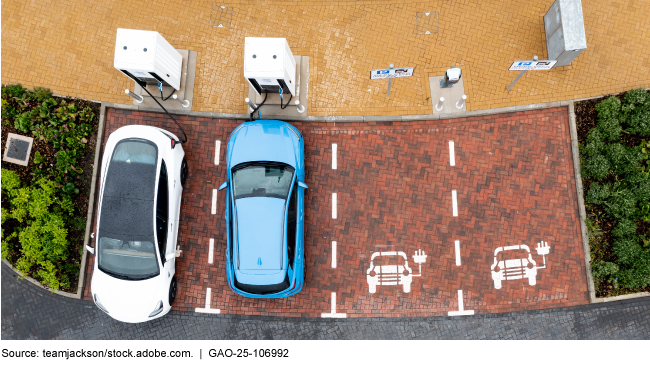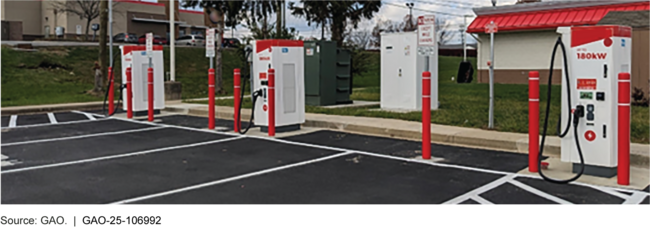Electric Vehicle Infrastructure: Improved Performance Management Needs to Be Part of Any Related Federal Efforts
Fast Facts
The number of electric vehicles on the nation’s roads has grown. But wider adoption of the vehicles may be slowed because there aren’t enough chargers available across the country.
Some federal programs aim to increase the number of chargers. For example, the government created a new Joint Office to help the Departments of Energy and Transportation collaborate and get federal funding to states and others building charger networks. But neither the Joint Office nor DOT have fully defined goals to track their progress.
Our recommendations address this and aim to help the agencies and Congress better understand the outcomes of these efforts.

Aerial view directly above electric car being charged
Highlights
What GAO Found
The number of electric vehicles in the U.S. has increased in recent years, but according to the Congressional Research Service the limited network of chargers presents a barrier to their adoption. The Department of Energy (DOE), Department of Transportation (DOT), and Joint Office of Energy and Transportation (Joint Office) have collaborated extensively to advance electric vehicle charging infrastructure. For example, DOE and DOT documented in 2021 how they would align their resources and expertise in establishing the Joint Office to facilitate an interagency approach to supporting charging infrastructure.
Charging Station Funded by the National Electric Vehicle Infrastructure Formula Program

The Joint Office has played a key role in coordinating efforts to advance a nationwide electric vehicle charging network, such as by providing technical assistance to state DOTs. Most stakeholders GAO interviewed in 2023 and 2024 (16 of 23) found the Joint Office's efforts to be helpful. The Joint Office has taken some steps to assess its activities, but GAO found it generally has not defined performance goals with measurable targets and time frames for its activities. Fully implementing a performance management framework that defines and assesses progress could better position the Joint Office to support DOE, DOT, and others involved in building the electric vehicle charging network. As of May 2025, the Joint Office was reviewing its efforts. Its future activities would benefit from finding ways to better use performance information to set priorities.
The Federal Highway Administration (FHWA), within DOT, administers two programs that support public electric vehicle charging infrastructure: the National Electric Vehicle Infrastructure Formula Program (NEVI) and the Charging and Fueling Infrastructure Discretionary Grant Program (CFI). As of April 2025, 384 NEVI- and CFI-funded chargers were open to the public. FHWA has identified long-term outcomes for the programs and collected some performance information, such as tracking the number of chargers. However, FHWA has not fully defined performance goals for some of the main purposes of NEVI, including improving access to electric vehicle chargers. Further, FHWA has not defined any performance goals for CFI that would enable it to assess progress in the near term. Fully implementing a performance management framework for the programs could help FHWA better achieve results and inform the public and Congress of the effectiveness of federal investments. As of May 2025, FHWA was reviewing NEVI and CFI activities. Improved performance management can help better convey the effectiveness of federal investments.
Why GAO Did This Study
States, localities, and private entities are working to build a nationwide network of publicly accessible electric vehicle chargers. DOE, DOT, and the Joint Office have supported the building of this network through the NEVI and CFI programs created under the Infrastructure Investment and Jobs Act (IIJA) in 2021. Related actions starting in 2025 are ongoing. These include an executive order to pause the disbursement of certain IIJA funds, DOT's initiation of a review of NEVI and CFI activities in alignment with current policies and priorities, and staff reductions at the Joint Office.
The Explanatory Statement accompanying the Consolidated Appropriations Act, 2022 includes a provision for GAO to assess federal efforts related to electric vehicle charging infrastructure. This report evaluates federal agencies' collaboration practices, the Joint Office's assessment of its activities, and FHWA's assessment of federal programs supporting charging infrastructure, among other objectives.
GAO reviewed relevant statutes and regulations; analyzed agency documents; compared agency efforts with leading practices; and interviewed agency officials and 23 stakeholders, such as state DOTs. Most of GAO's work was completed by January 2025 and does not assess changes since then.
Recommendations
GAO is making three recommendations, including that the Joint Office and DOT fully implement a performance management framework. The Joint Office and DOT did not take a position on GAO's recommendations.
Recommendations for Executive Action
| Agency Affected | Recommendation | Status |
|---|---|---|
| Joint Office of Energy and Transportation | The Executive Director of the Joint Office should fully implement a performance management framework that defines and assesses progress toward performance goals. (Recommendation 1) |
When we confirm what actions the agency has taken in response to this recommendation, we will provide updated information.
|
| Department of Transportation | The Secretary of Transportation should direct the FHWA Administrator to fully implement a performance management framework for NEVI that defines and assesses progress toward performance goals. (Recommendation 2) |
When we confirm what actions the agency has taken in response to this recommendation, we will provide updated information.
|
| Department of Transportation | The Secretary of Transportation should direct the FHWA Administrator to fully implement a performance management framework for CFI that defines and assesses progress toward performance goals. (Recommendation 3) |
When we confirm what actions the agency has taken in response to this recommendation, we will provide updated information.
|
